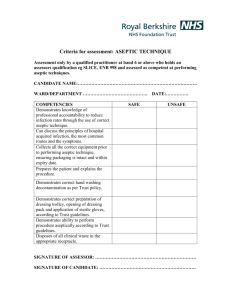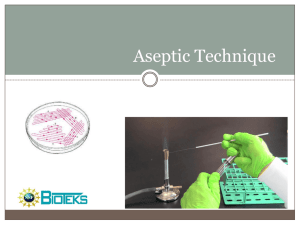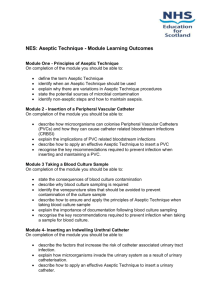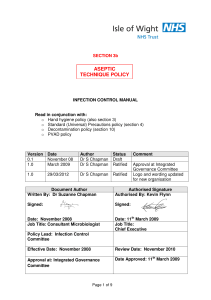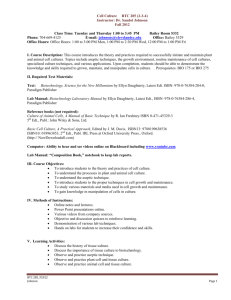Aseptic technique guide.
advertisement
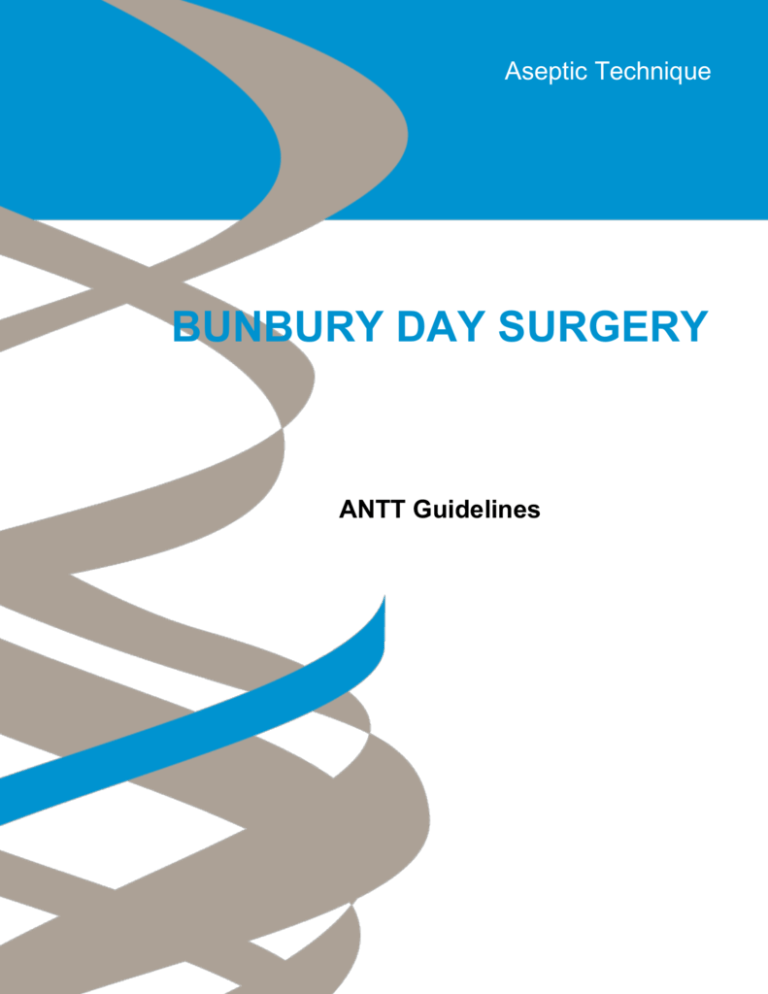
Aseptic Technique BUNBURY DAY SURGERY ANTT Guidelines Table of Content What is Aseptic technique? ................................................................................... 2 Core infection control components:....................................................................... 2 Key Parts .............................................................................................................. 4 References: .......................................................................................................... 5 Aseptic Technique Workbook June 2013-Version 1 BDS 1 The ANTT model for establishing aseptic technique ANTT is a contemporary and unique Theoretical and Clinical Practice Framework for aseptic technique for all clinical procedures…’from surgery to community care’. It is endorsed or referenced as a best practice example of standardized aseptic technique by a number of organizations including, Epic2 (Pratt et al 2007), The National Institute for Clinical Excellence (NICE 2012), The Australian Guidelines for the Prevention and Control of Infection in Healthcare (ACSQH 2010) the Royal College of Nursing (RCN) Infusion Standards 2010, The American Vascular Access Society (AVA), the Health Protection Surveillance Centre – Ireland (2011). What is Aseptic technique? Asepsis / Aseptic technique Describes the infection prevention aim and method adopted by health care professionals when undertaking invasive clinical procedures. Regardless of setting or patient diagnosis, the aim is always to prevent the transfer of pathogenic microorganisms from the healthcare worker, procedure equipment or the immediate working environment into and onto the patient. In ANTT, it is achieved by ensuring Key-Parts and Key-Sites remain aseptic by a concept termed Key-Part and Key-Site-Protection. This is achieved by correct: 1. Hand hygiene, 2. Non touch technique, 3. Using new sterilised equipment and or 4. Cleaning existing key parts to a standard that renders them aseptic prior to use. Whilst the principles of aseptic technique remain the same, the level of practice will change according to the risk identified using a standard aseptic technique risk assessment. The standard risk assessment involves assessment of technical difficulty and staff competence in maintaining asepsis. This package has been developed to provide all clinical staff knowledge in aseptic technique in accordance with the Australian Guidelines for the Prevention and Control of Infection in Healthcare (2010). Core infection control components: 1. Key parts and key sites identification and protection - key parts must be identified and protected at all times. Aseptic key parts must only come into contact with other aseptic key parts and / or key sites. 2. Hand hygiene – Effective hand hygiene is an essential part of aseptic technique. In standard aseptic technique hand hygiene should be performed using neutral pH soap and running water or alcohol based hand rub. A surgical hand scrub is required for surgical aseptic technique. It is known that hand hygiene is not always performed correctly thus identifying key parts and not touching them is vital in maintaining asepsis. Aseptic Technique July 2013 -Version 1 2 3. Glove use – if it is necessary to touch key parts or key sites directly, sterile gloves are used to minimize risk of contamination, body fluid exposure and / or exposure to any drugs that may be administered during the procedure. 4. Aseptic fields – aseptic fields are important in providing a controlled aseptic working space to help maintain integrity of the asepsis during clinical procedures. Size of the aseptic field will be dependent upon the complexity of the procedure to be performed. > Critical aseptic fields are used when key parts and or key sites (usually due to their size or number), cannot be easily protected at all times with covers and caps, or handled at all times by non touch technique. These include PICC lines, urinary catheter insertion, and complex wound care. The other critical aseptic field is in the operating theatres. > Critical micro aseptic fields involve covering or protecting key parts with syringe caps, sheaths, covers or packaging. The inside of caps and covers is sterile and provides optimum aseptic field for key parts. > General aseptic fields are used for standard aseptic technique when key parts can be easily and optimally protected. The main general aseptic field does not have to be managed as a key part and is essentially promoting rather than ensuring asepsis. 5. Standard Aseptic technique > Typically short duration procedures (less than 20 minutes) > Technically simple procedures > Involve relatively few and small key sites and key parts > Require main general aseptic field and non sterile gloves > Use of critical micro aseptic fields and non touch technique is essential to protect key parts and key sites Examples include IV therapy, simple wound dressings, and if staff member is experienced in urinary catheterization and IV cannulation. Surgical Aseptic technique > Technically complex procedures > Involve extended period of time > Large open key sites or large or numerous key parts > Require main critical aseptic field and sterile gloves and full barrier precautions > Use of critical aseptic fields and non touch technique is used where practical to do so Examples include urinary catheterization in non-experienced staff member, IV cannulation with non experienced staff member, plus complex / large dressings, PICC / CVC insertion & surgery. Aseptic Technique July 2013 -Version 1 3 6. Environment Control Prior to conducting an aseptic procedure, health care workers should ensure that there are no avoidable environmental risk factors nearby such as bed making or patients using commodes. Key Parts 1. Aseptic technique for Peripheral Intravenous Therapy Key Parts include – > Syringe tip > Needle – both needle tip and hub > Needle Free Access device / bung on catheter lumen > IV infusion lines including fluid bag spikes, all bungs, caps, 3 way taps, all infusion ports, the end of the infusion line which connects to patient > Extension lines – both end that connects to patient and end that connects to IV administration set > The hub of both central and peripheral access devices > The tip of the implanted port needle & the hub end > The dressing > Rubber tops on vials containing medication > Syringe access point of any IV medication / fluid 2. Aseptic technique for wound care (outside the operating theatre) Key parts include – > Tips of forceps > Gauze / swabs used to cleanse wound > Suture remover tip (if applicable) > Staple remover tips (if applicable) > Scissor tips (if applicable) > Dressing to be applied / side directly over the wound 3. Aseptic technique for insertion of urinary catheter (male / female) Key parts include – > Forcep handle in dominant hand > Urinary catheter – both ends and hub for injecting sterile water > Lubricant tip & handle (used in dominant hand) > Tip of urinary drainage bag that connects to urinary catheter > Syringe tip > Sterile water for injection opening Aseptic Technique July 2013 -Version 1 4 References: 1. National Health & Medical Research Council. (2010) Australian Guidelines for the Prevention and Control of Infection in Healthcare. 2. Noosa & Nambour Selangor Private Hospital. (2012) Aseptic technique workbook & competencies 3. The Australian College of Operating Room Nurses Ltd. ACORN Standards for perioperative nursing. 2012 – 2013. Adelaide, South Australia Aseptic Technique July 2013 -Version 1 5
